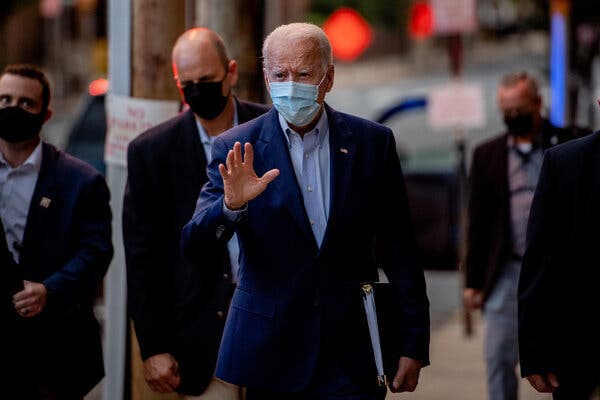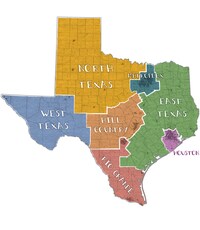Advertisement
Poll Watch
With the coronavirus raging in the state, particularly in the politically competitive northeast, the president faces an uphill battle to repeat his 2016 victory.

Welcome to Poll Watch, our weekly look at polling data and survey research on the candidates, voters and issues that will shape the 2020 election. Follow our daily updates on the latest presidential election polls.
You know the story well: Not a single public poll in 2016 showed Donald J. Trump beating Hillary Clinton in Wisconsin, and forecasters suggested he had almost no shot. FiveThirtyEight gave him less than a one-in-six chance of winning the state.
But after the votes were counted, with turnout down in key Democratic areas, Mr. Trump eked out a victory by fewer than 30,000 votes.
This year, again, virtually every poll has shown the Democrat, Joseph R. Biden Jr., with at least a slight edge over Mr. Trump. A New York Times/Siena College survey last month gave Mr. Biden a five-percentage-point advantage among likely voters. Polls taken since then by CNN and NBC News/Marist College have each given Mr. Biden an outright, 10-point lead.
And with the coronavirus now raging in Wisconsin, particularly in the politically competitive northeastern region, Mr. Trump faces an uphill battle toward repeating his victory from four years ago.
“Certainly, with the sharp rise in cases here, it’s on the agenda for voters,” said Charles Franklin, a political scientist who runs the Marquette Law School poll, which is seen as the definitive political survey in the state. “His handling of Covid does appear to be having a bigger effect on people’s vote than either the economy or his handling of the protests.”
Marquette has released a Wisconsin poll each month since June, and in every one Mr. Biden has held a single-digit lead among likely voters that was within the margin of error. This reflects the steadiness of a race in which Wisconsinites largely know where they stand: Roughly four in five voters have consistently expressed a strong opinion of Mr. Trump’s leadership, whether positive or negative, according to Marquette’s data.
But if there are any small signs of momentum, it appears to be breaking Mr. Biden’s way. His 48 percent approval rating in the poll released this week was his best in a Marquette survey all year, capping a 14-point rise since February. Mr. Trump, meanwhile, was seen positively by 42 percent of Wisconsin voters, leaving his net favorability rating more than 10 points in the red, where it has languished since June.
Concern about the pandemic has ticked upward recently. More than six in 10 Wisconsin voters in the Marquette poll described themselves as at least fairly worried — including 27 percent who said they were very worried, up from 21 percent last month. Fully 50 percent of Wisconsin voters said they did not expect the virus to be under control for at least another year, running counter to Mr. Trump’s insistence that it is already being handled effectively.
And that’s not the only issue where he’s hurting. While Mr. Trump has made Wisconsin a focal point of his “law and order” messaging, particularly after protests broke out over the police shooting of Jacob Blake in Kenosha, Wis., 54 percent of Wisconsin voters said in the Marquette survey that they disapproved of how he had handled this year’s unrest. Just 37 percent approved.
Since the rise of the Tea Party movement a decade ago, white men without college degrees in Wisconsin have shifted toward the Republican Party in large numbers — a development that predated Mr. Trump’s rise, but that he certainly accelerated. Dr. Franklin cited Marquette numbers showing that in 2012, non-college-educated white men in Wisconsin were just five points more likely to be Republicans than Democrats. By this year, the difference had grown to 23 points.
Dr. Franklin said that former Gov. Scott Walker, a Republican, had introduced a newly working-class political lexicon in the early 2010s, when he waged an attack on public-sector unions.
“Walker didn’t spend as much time emphasizing pro-business messages in a way that you would’ve heard previous generations of Republicans saying, ‘What’s good for business is good for the state,’” Dr. Franklin said. “Walker was saying: ‘They’re hard-working taxpayers who need their money, and these unions are taking money from them.’”
But as much as Republicans’ appeals have resonated with many working-class white men, there has not been commensurate movement among women without college degrees. And while Democrats haven’t notched big gains in their vote share among any particular group, they have avoided losing ground among demographics that are growing more quickly — such as college graduates, Latinos and voters in cities.
In Democratic strongholds like Milwaukee and Madison, the state’s two biggest municipalities, the margins actually improved slightly for Democrats between the 2012 and 2016 presidential elections. Dane County, which includes Madison, is the state’s fastest-growing county, and is probably the No. 1 area where Democrats will be looking to run up the score.


